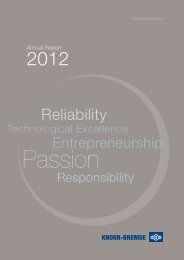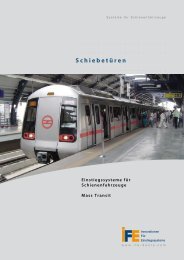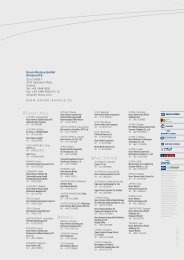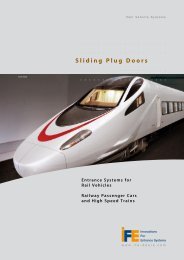Annual Report 2010 - Knorr-Bremse AG.
Annual Report 2010 - Knorr-Bremse AG.
Annual Report 2010 - Knorr-Bremse AG.
You also want an ePaper? Increase the reach of your titles
YUMPU automatically turns print PDFs into web optimized ePapers that Google loves.
RepoRt<br />
103<br />
20-inch disc brake for China<br />
Unlike in Europe and North America, commercial vehicles in China use tires with inner tubes. This creates<br />
a wheel contour that provides less space for disc brakes. To cope with this reduced installation<br />
envelope <strong>Knorr</strong>-<strong>Bremse</strong> has developed a special design of brake with an internal mechanism based on<br />
the well-known disc brake concept that has sold in its millions in the company’s core markets.<br />
In <strong>2010</strong> the process of localizing production of the 20-inch disc brake began, including the development<br />
of a local supply infrastructure. At the same time the process began of transferring an entire disc<br />
brake assembly line from the German site in Aldersbach to Dalian, China.<br />
ABS for BRIC<br />
With more than 20 years’ experience of designing electronic brake control systems, <strong>Knorr</strong>-<strong>Bremse</strong> is<br />
the world’s leading manufacturer of ABS systems. This means <strong>Knorr</strong>-<strong>Bremse</strong> Commercial Vehicle Systems<br />
is well placed for accessing BRIC markets.<br />
With its ABS system specially designed for the BRIC states, <strong>Knorr</strong>-<strong>Bremse</strong> offers a scaleable, cost-effective<br />
solution that meets the needs of these countries. The system covers a wide range of functions: It<br />
has to meet certain minimum requirements but also has to be modular in design and capable of being<br />
customized to regional customers’ requirements. The ABS is therefore available with integrated ESP<br />
function on the one hand, and on the other hand can also reproduce electronic brake control functions.<br />
PBS – Pneumatic Booster System<br />
The concept underlying this development is both simple and ingenious: the Pneumatic Booster System<br />
(PBS) utilizes the compressed air that has already been generated for the braking system, injecting<br />
measured amounts briefly into the inlet manifold of the engine to boost its short-term performance.<br />
Within half a second the engine has enough oxygen to eliminate so-called “turbo lag” during acceleration.<br />
This brief but significant improvement in performance enables the driver to change up faster and<br />
maintain lower average engine revs without affecting performance.<br />
This short-term boost in engine performance is not only useful during drive-off and overtaking. The<br />
acceleration of a vehicle equipped with the Pneumatic Booster System is comparable to one with a<br />
20% to 30% higher cubic capacity – which means PBS is of considerable benefit to BRIC states, where<br />
vehicles are traditionally fitted with smaller engines.








![Geschäftsbericht 2012 [PDF, 13 MB] - Zelisko](https://img.yumpu.com/22524926/1/184x260/geschaftsbericht-2012-pdf-13-mb-zelisko.jpg?quality=85)







